October Fungi Focus: Blackening Waxcap (Hygrocybe conica)

We are now in the peak season for mushrooms and toadstools, and UK Fungus Day, this Saturday 8th October, seems as good a time as any to get out into nature and have a look at what’s around. But while this blog tends to be woodland related by the very fact of it appearing on this website, when it comes to the role of fungi in our wider ecosystems, it can be easy to miss the wood for the trees. Fungi might have a fairytale association with forests, but we all know that they do grow in other places. Take our most common commercially grown edible, for example, Agaricus bisporus – a fungi so familiar it goes by a plethora of common names, including common, white and chestnut mushroom. The British Mycological Society list ‘Cultivated Mushroom’ as it’s official common name, but when it is found growing naturally, it is almost always on grasslands of some description, just like the larger closely-related Field Mushroom (Agaricus campestris).
So let us take a temporary foray out of the forest into fresh pastures this month, where we shall focus on an eye-catching and particularly interesting group of grassland fungi whose importance to the natural world needs a lot more appreciation and investigation: the waxcaps.
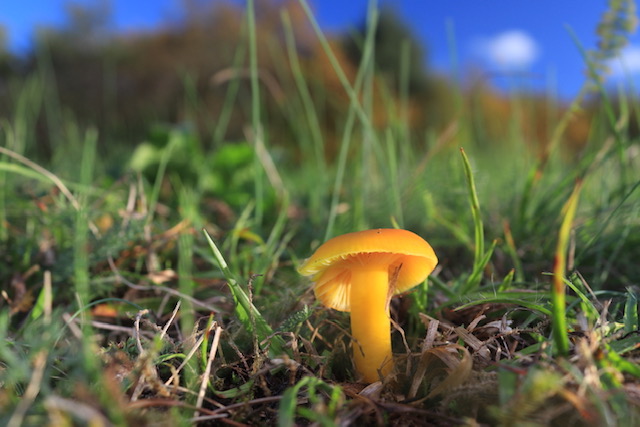
Butter Waxcap (Hygrocybe ceracea)
There’s a whole swathe of mushrooms one might see growing in fields and parklands and other grassy areas. Most are saprophytic, growing on decaying organic matter, like such well-known varieties as the Shaggy Inkcap and the majestic Parasol Mushroom, and you might see other types like the Egghead Mottlegill or the Stubble Rosegill growing in animal dung or among hedge cuttings or other organic litter at the edge of fields and pathways.
The waxcaps, however, prefer “unimproved” grasslands, by which it is meant that the ground has been left undisturbed and has not been reseeded for some time, it is nutrient poor and has not been dosed with artificial fertilisers, and is most likely used as either permanent pasture or a regular hay cropping.
According to the book ‘Grassland Fungi: A Field Guide’ (2017), by Elsa Wood and Jon Dunkelman, such short-sward, nutrient-poor areas tend to be rich in wildflower species and a good moss flora is present. This latter point is important, because while waxcaps have been thought of both as being saprophytic and mycorrhizal (growing in association with plant roots), current research seems to suggest they grow in association with grassland mosses.
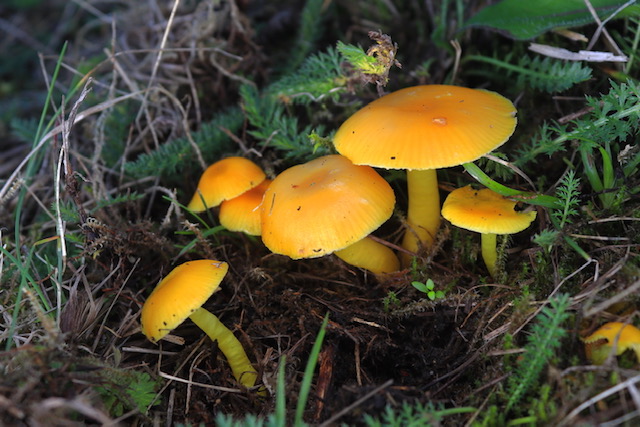
Butter Waxcap (Hygrocybe ceracea) amongst the moss
As such, waxcaps are incredibly useful environment indicators, and one of the key species types in a system known as CHEGD proposed by a certain E. Rald in Denmark in 1985 for evaluating the conservation value of a given grassland. CHEGD refers to five groups of fungi whose presence signifies a healthy grassland: Clavaroids such as club, coral and spindle fungi; the waxcaps are the H for Hygrocybe (literally meaning “wet head”); Enteloma, or pinkgills; Geoglossum, or earthtongues; and Dermoloma, a genus commonly referred to as “Crazed Caps”. There have subsequently been a few additions to the system and the taxonomical revisions that seem to regularly hit the world of mycology mean that Hygrocybe has been split into several other genuses that also refer to waxcaps, including Cuphophyllus and Gliophorus. Nevertheless, the name CHEGD and the principles behind it still stand.
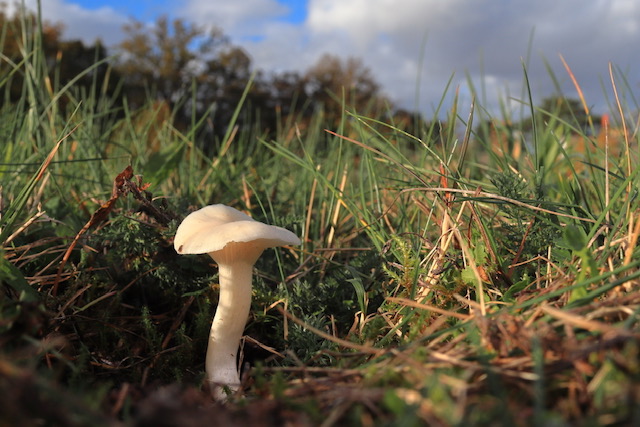
Snowy Waxcap (Cuphophyllus virgineus)
Unimproved grassland habitats are few and far between in some parts of the world, with many of our large, open areas given over to agricultural practices that favour the rapid rotation of crops, for example, or they are earmarked for building houses upon. Ancient grasslands might not get as much attention in environmental conservation and restoration as woodlands or even wetlands, but it is thought that the hyphal mats of the CHEGD fungi are likely good carbons stores in their own right which could easily be destroyed if ploughed or otherwise disrupted – so planting trees in grassland habitats might not reap the dividends in terms of carbon offsetting that some might have us believe.
Village greens and graveyards are among the kind of environmentally unsullied areas one might expect to find waxcaps, but it seems the British Isles is rather blessed in terms of unimproved ancient grasslands, from the South Downs in Sussex to Hadrian’s Wall and in particular Scotland and Wales, from heaths to sand dunes and coastal slopes, and from hay meadows to roadside verges and the lawns of stately homes, as I discovered in a fascinating online talk given by Sean Cooch and Clare Blencowe this summer which was recorded and can be seen viewed here.
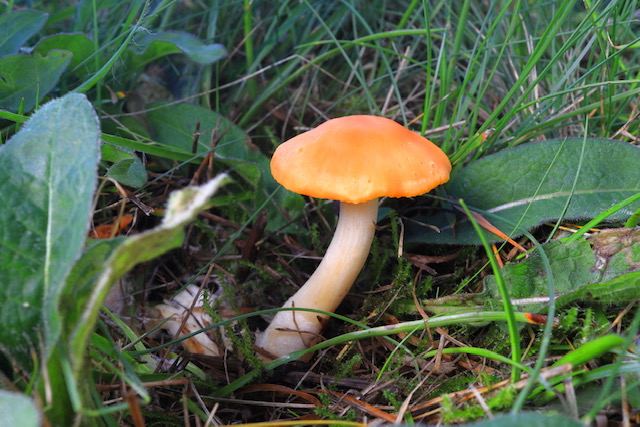
Meadow Waxcap (Cuphophyllus pratensis)
As I mentioned in my July piece on the Beefsteak Fungus, we have quite a few fungi species in the United Kingdom which are relatively common here while rare on the European mainland, and we need to make more people aware of this, so that their habits are preserved and ancient trees are not chopped down or vital fields ploughed (such as with this regrettable faux pas by the National Trust last year). Habitat loss is key to the scarcity of the Date Waxcap (Hygrocybe spadicea), one of Britain’s rarest fungi, which is one of five species of grassland fungi that appear in the Section 42 list “Species of Principal Importance to the Conservation of Biodiversity in Wales”, meaning public bodies have a duty towards their conservation. It is the only waxcap on the list, which also includes Violet Coral (Clavaria zollingeri), Big Blue Pinkgill (Entoloma bloxamii), Olive Earthtongue (Microglossum olivaceum) and Dark-purple Earthtongue (Geoglossum atropurpureum).
There are about 50 species of waxcaps in the UK, and while I’m not going to go into detail about them individually, the names alone should point towards their beautiful range of colours: Scarlet Waxcap (Hygrocybe coccinea), Snowy Waxcap (Cuphophyllus virgineus), Honey Waxcap (Hygrocybe reidii), Splendid Waxcap (Hygrocybe splendidissima) and the Pink or Ballerina Waxcap (Hygrocybe calyptriformis).
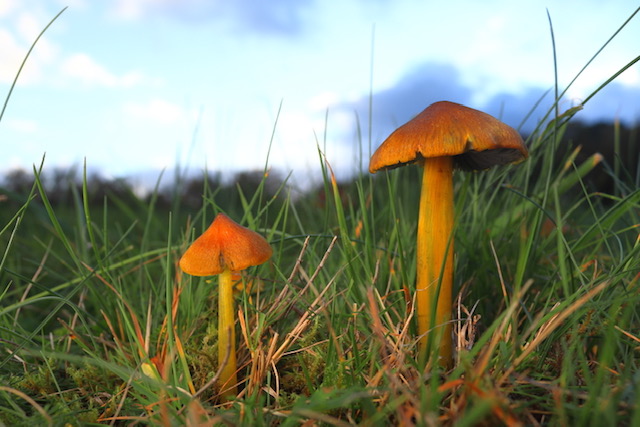
Blackening Waxcap (Hygrocybe conica)
I’m opting for the Blackening Waxcap (Hygrocybe conica) as my fungi of focus for this post, in that it is the most easily to recognise: while its sticky and distinctively conical caps start off in a range of colours between red and orange, as they age or are damaged, they blacken in a quite unmistakeable manner, eventually going completely black and looking a bit like a witches hat. It is also the most common, although now it is thought that rather than a single species, it is actually a species complex or a group of very closely related separate species.
Waxcaps are most commonly found from mid-September to the first frosts in November. If the colours and textures of these beautiful fungi aren’t enough to get you out and about hunting, then like the Standing Oak Tree Fungus Survey I mentioned in my Beefsteak Fungi post, the Waxcap Watch Survey currently being conducted by the international conservation organisation Plantlife might provide further incentive to get involved in an invaluable citizen science project.

A Blackening Waxcap beginning to blacken.
No real mycological knowledge is needed for this. The basic guide is to find a suitable area and check it out for these CHEGD, and only record the number of different colours of what you find. Whether you find much or don’t, enter the results using the App downloaded from the website, and they will be recorded on this interactive map. Some sites might not yield much, but they will at least be marked on the map as a red dot meaning “not much was recorded at this site but it’s worth having a look another time.” In contract, Green will show a vast diversity of species, with orange somewhere in between.
I’ve not entered any data myself at the moment, as I’ve not found anything yet this year, but whereas the evidence shows a great waxcap diversity of sites in Wales, Scotland and the Southwest of England, there is little evidence of anything in my surrounding area in Kent. This is certainly not to say there’s nothing there. In previous years I have discovered a good variety of waxcap species in the village of Keston, just outside Bromley, a Parrot Waxcap in the grounds of Walmer Castle, and Blackening Waxcaps aplenty in the reclaimed coal spoil site of Betteshanger Park outside Deal. I am clearly overdue a revisit to these sites to record these finds.
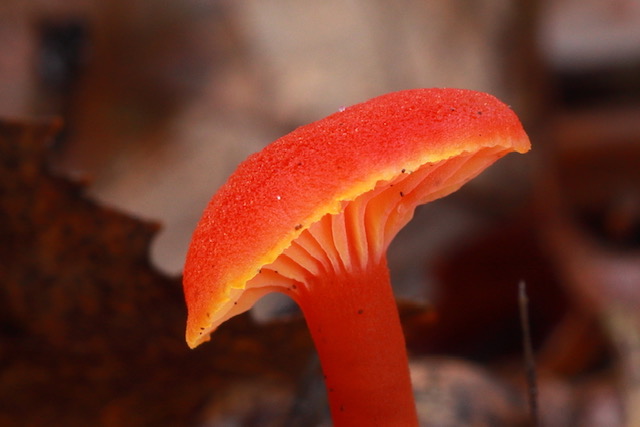
The astonishing colours and textures of the Goblet Waxcap (Hygrocybe cantharellus)
For those who wish to dig deeper into the subject, there’s a free downloadable PDF on the Plantlife website providing a basic guide to the identification and management of waxcap and grassland fungi, listing about a dozen species. A fuller range can be looked in this dedicated section in the fabulous First Nature website, and if the sheer number look a bit daunting, then you’ll be happy to read that the Sussex Biodiversity Record Centre has provided this online Grassland Waxcap Identification Support Tool. Clare Blencowe details her love of waxcaps and the process behind developing this tool in the Newsletter of the National Forum for Biological Recording issue 58. And finally, the University of Aberystwyth provide a wealth of information on their Waxcap Website.
Hopefully this will spur some of you on to head out into the grasslands on UK Fungus day and beyond to record your findings for the Waxcap Watch Survey. This kind of data provided by citizen scientists could prove really useful in making sure our unimproved or “unspoilt” natural areas remain so, and while there’s never been a case of a mushroom stopping a housing development, building up a public awareness of what we have in this country is essential.
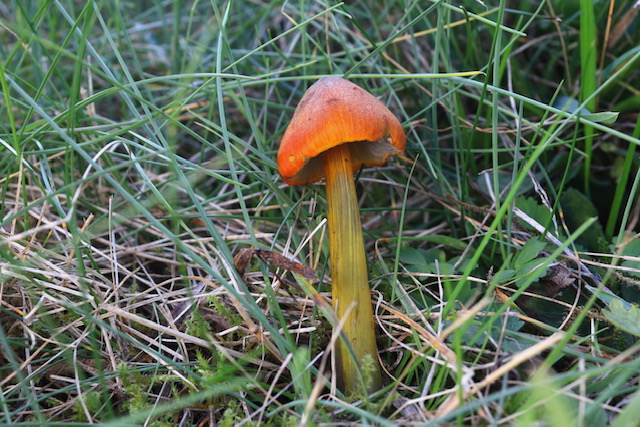
Blackening Waxcap
Comments are closed for this post.
Discussion
You do not say if the mushrooms are edible and/or if they are protected from being picked.
To the woods!

In general, Ian, I don’t talk about edibility in these posts. Probably the ratio of edible to non-edible fungi in the UK is about the same as that of plants, and one might say the same thing – that some are edible and worthwhile eating, some are not worth the bother, and some will kill you, while some like orchids are rare and we don’t really know the effect picking the fruit body has on the organism itself.
I’ve never considered eating waxcaps myself. While none are among the 4 red-listed species in the UK that are illegal to pick, the Date Waxcap is considered very rare and in need of conservation.
I think the take-home point here is about the importance of habitat to these fungi and how they might also stand more generally as environmental markers of the health and function of these particular grassland habitats.
Jasper
7 November, 2022